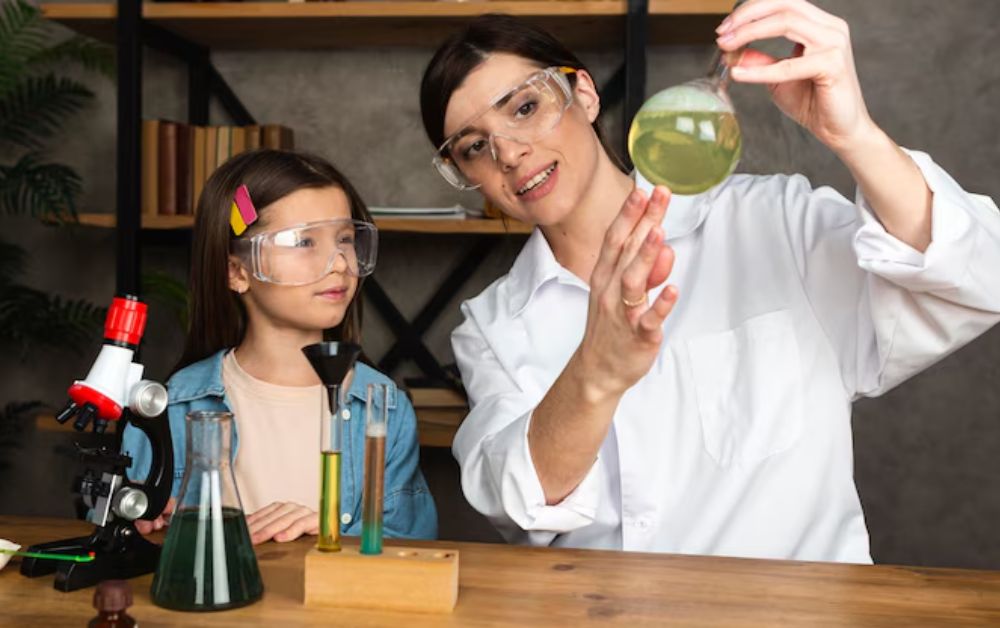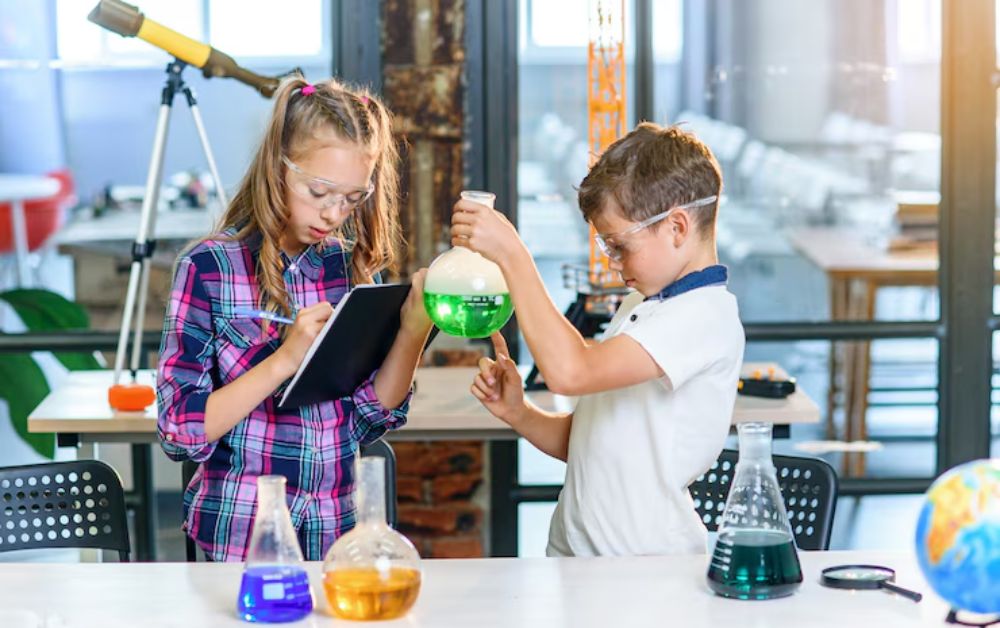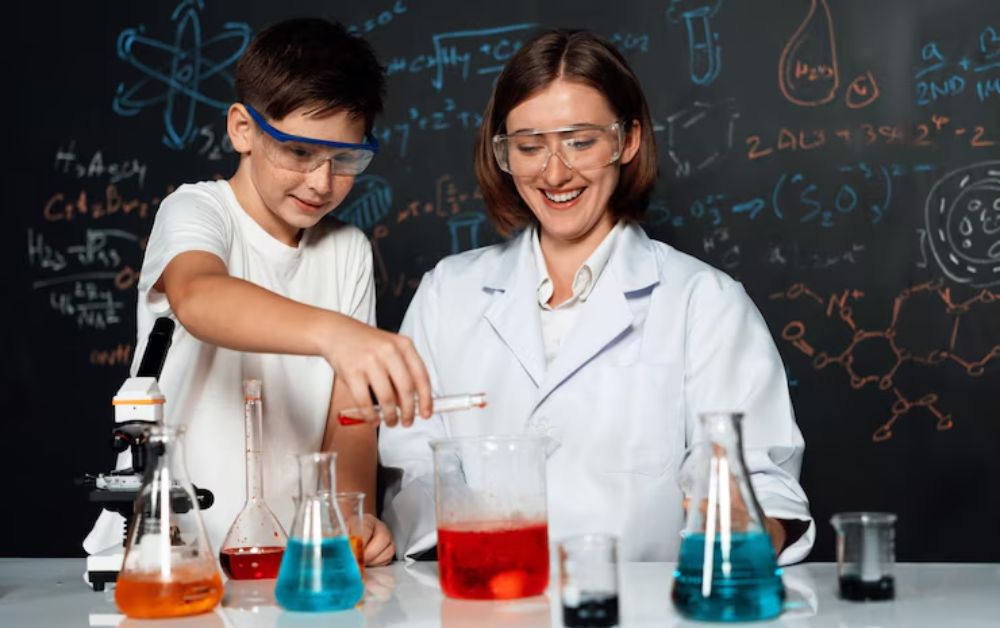
Understanding the Basics of Chemistry: A Beginner’s Guide
Chemistry is called the “central science” because it bridges and overlaps with many other scientific fields, ranging from biology and physics to geology and environmental science. Chemistry, at its simplest, is the study of matter—what it consists of, how it acts, and how it changes. Whether you are an inquisitive student beginning your science adventure or merely interested in how the world functions, learning chemistry fundamentals is an essential starting point. This beginner’s guide breaks down crucial concepts and provides a solid foundation for future investigation.

What is Chemistry?
Chemistry is the scientific study of matter’s composition, structure, properties, and changes. Everything around you—air, water, food, and even your body—comprises chemicals. These chemicals are made up of atoms and molecules that interact with each other in different ways. Chemistry allows us to describe why ice melts, how drugs work, or what happens when you heat food.
The Building Blocks of Matter: Atoms and Elements
At its most fundamental level, everything in the universe is composed of atoms. An atom comprises three principal subatomic particles: protons, neutrons, and electrons. Protons and neutrons make up the nucleus at the center of the atom, and electrons orbit around the nucleus in shells.
Elements are chemically pure substances composed of just one kind of atom. Every element possesses characteristic traits and is indicated by a symbol on the Periodic Table of Elements. For instance, hydrogen (H), oxygen (O), and carbon (C) are everyday elements. There are 118 identified elements, and every single one has its purpose within the universe’s composition.
The Periodic Table: A Chemist’s Roadmap
The Periodic Table is one of the significant tools used in chemistry. The Periodic Table classifies elements according to atomic number, electron configuration, and periodic chemical properties. Elements are placed in periods (rows) and groups (columns). The elements within the same group have similar properties. For instance, noble gases (such as helium and neon) are non-reactive, whereas alkali metals (such as sodium and potassium) are very reactive.
Knowing the structure of the Periodic Table can predict how elements will behave and interact with one another.
Chemical Bonds and Compounds
Atoms are not usually found alone. They prefer to bond with other atoms to create compounds. There are three different types of chemical bonds:
- Ionic Bonds: created when electrons are moved from one atom to another, producing charged ions. It is found in salts such as sodium chloride (NaCl).
- Covalent Bonds: where atoms exchange electrons. Water (H₂O) is a familiar example.
- Metallic Bonds: in metals, electrons are exchanged in a “sea” where conductivity and malleability are possible.
Compounds are chemicals composed of two or more elements bonded in definite proportions. Their properties may differ from those of the elements they are composed of.
States of Matter and Changes in States
Matter may be in various physical states: solid, liquid, gas, and plasma. Each state has unique characteristics concerning shape, volume, and particle motion:
- Solids possess fixed shapes and volumes.
- Liquids possess fixed volume but assume the shape of the container.
- Gases possess neither fixed shape nor volume.
- Plasma, which occurs in stars and neon lights, comprises ionized gases.
Matter can also be transformed from one state into another through various processes such as melting, freezing, condensation, evaporation, and sublimation. These transformations are usually physical, so the substance does not undergo chemical change.
Chemical Reactions: Making and Breaking Bonds
A chemical reaction is where substances react with each other to create new substances that have dissimilar properties. During a chemical reaction, a bond between two atoms is disrupted, and a new bond is established. Chemical reactions may release energy (exothermic) or trap energy (endothermic).
Example:
- Combustion: burning of wood or gasoline produces heat and light.
- Photosynthesis: plant life takes sun, carbon dioxide, and water and converts these into glucose and oxygen.
Reactants are the initial substances, and products are the new substances that are formed. Chemical equations depict these reactions in terms of symbols and formulas.
Acids, Bases, and the pH Scale
Another significant concept in chemistry is the concept of acids and bases. Acids give hydrogen ions (H⁺) in solution, whereas bases give hydroxide ions (OH⁻). The pH scale, from 0 to 14, quantifies how acidic or basic a substance is:
- pH 0–6: Acidic (such as lemon juice, vinegar)
- pH 7: Neutral (such as pure water)
- pH 8–14: Basic or alkaline (such as baking soda, soap)
Acids and bases are essential to understand in areas of study, from medicine to environmental science.
Why Chemistry Matters in Everyday Life
You may not know it, but chemistry is all around you. It helps us know:
- Why soap removes dirt from your hands
- How food is digested in your body
- What occurs when you combine baking soda and vinegar
- How drugs interact with your body
From household cleaners and cooking to operating a car and charging electronics, chemistry is essential to everyday life.
Beginner Tips for Learning Chemistry
If you’re new to chemistry, here are some tips to remember:
- Learn the language: Chemistry has its vocabulary. Begin by getting familiar with standard vocabulary and symbols.
- Practice problem-solving: Balance equations and learn formulas.
- Use visuals: Models, diagrams, and videos assist in understanding abstract things more quickly.
- Stay curious: Question and investigate how chemistry is used in things you see and use daily.
- Build a strong foundation: Learn the fundamentals before progressing to more complicated topics.

Conclusion
Learning chemistry fundamentals opens the door to a greater appreciation of the world around you. Chemistry describes how matter moves and interacts, from elements and atoms to reactions and solutions. Although the discipline may appear scary at first glance, beginning at the beginning may make it much easier to handle. Whatever your plans in science or even if you merely wish to sate your curiosity, learning chemistry basics is well worth the investment.
